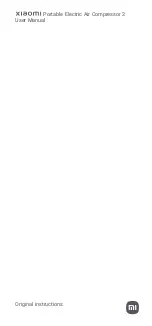
4.4 Safety devices
The following safety devices are provided and may not be modified in any way.
■ Pressure relief valve:
The pressure relief valve protects the system against excessive pressure. It is factory set.
■ Housing and covers for moving parts and electrical connections:
Protect against accidental contact.
4.4.1 Safety and regulating devices
Install the following safety and control devices at the user side:
■ EMERGENCY STOP control device:
Stops the machine immediately in an emergency situation. The motor is stopped. The pressure
system is vented.
■ Pressure relief valve:
The pressure relief valve protects the user's air receiver against excessive pressure.
■ Check valve:
The check valve prevents the flow of compressed air from the air receiver back to the com‐
pressor block when the machine is stopped.
Install the valve between the compressed air outlet and the user's shut off valve.
Provide means of venting in the pressure line between the machine and the check valve and
between the check valve and the user's shut-off valve.
The sizing of the check valve is dependent on the maximum working pressure and the cross-
section of the connection between the compressor and the air network.
■ Pressure switch:
The pressure switch regulates the working pressure of the air network. The pressure switch
toggles the compressor between LOAD and READY to maintain a constant working pressure.
■ Pressure gauge:
The pressure gauge monitors the working pressure in the user's air receiver.
Select the pressure gauge according to the maximum working pressure.
■ Motor protection:
The motor protection device shuts down the machine:
─ in the case of a phase drop-out overload,
─ if the ambient temperature becomes too high,
─ if the compressor block seizes, or
─ if the mains voltage fluctuates outside limits.
AC motors may be operated only with correctly set motor protection switch or overload relay.
The warranty is void without motor protection.
■ Safety signs:
The machine has been delivered with all necessary safety signs.
Upon installation, the safety-relevant labeling of the entire system must be checked and exten‐
ded, if required.
Further information See chapter 6.7 for an example of the arrangement of the safety installations to be installed by the
user.
4
Design and Function
4.4
Safety devices
30
Assembly and operating manual 1-stage piston compressor
EPC-G
No.: 9_5752 24 E
















































